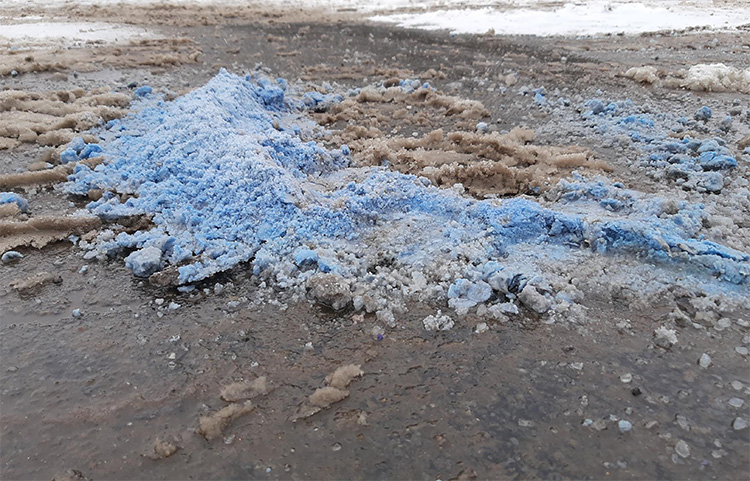
Task Force Report Marks Major Step Forward in our Fight Against Road Salt
By: Aimee Privitera - The Adirondack Council's Legislative Associate
Thursday, September 14, 2023
This is part one of a series detailing road salt usage in the North Country, the history of the Adirondack Council's involvement in its reduction, and the path forward.
A low-sodium diet. My doctor's advice for my father and Council's advice for Adirondack roadways.
This advice isn't new. The Council has been tracking road salt pollution for more than 14 years. My Dad has been tracking his diet for… somehow even longer.
Last week, the Adirondack Road Salt Reduction Task Force released its long-awaited report, which contains recommendations that, if acted upon, would significantly reduce road salt pollution entering Adirondack waters. While the Adirondack Council has called for a low-sodium diet for some time, this tongue-in-cheek clarion call is admittedly only half of the needed solution: chlorides also pollute our Adirondack waters. While it is a critical time for the state to lean into the implementation of task force recommendations, this also feels like a necessary time to reflect on some of the measures that have brought us to this place in time.

The 1980 Winter Olympics in Lake Placid marked a significant shift in winter road maintenance in the Adirondack region. Roads historically managed as "winter hard pack," maintained with plowing and sanding, were deemed insufficient to support the hordes of visitors flocking to the region. Salt would aid road managers in achieving bare road driving conditions on the major thoroughfares. Unfortunately, the appetite for salt never went away.
In the Adirondacks, there are 10,555 lane-miles of paved roads. State roads, managed by the NYS Dept. of Transportation (NYSDOT), comprise 2,830 of these lane miles (approximately 27%), while local roads comprise 7,725 of these lane miles (73%). However, it is estimated 56% of all road salt administered in the Park is applied on state roads, and just 44% is applied to nearly three-quarters of the paved roads inside the Blue Line. Since the 1980 Olympics, more than six million tons of road salt have been applied to Adirondack roadways. That's enough road salt to fill an Olympic-sized swimming pool for each lane-mile of road in the Park, and that salt had to go somewhere. Researchers have documented increasing salinization of both groundwater and surface waters, predominantly along state roadways.

The Adirondack Council's History – Advocating for Road Salt Reduction
In 2009, the Adirondack Council published the "Low Sodium Diet" Report, an analysis of winter road maintenance practices, negative impacts of salt pollution, and recommendations for road salt reduction and alternatives. Harnessing this momentum, the Adirondack Council partnered with AdkAction to host the three road salt reduction conferences at Paul Smith's College over the next decade.
During that time, the NYSDOT convened a Road Salt Working Group in partnership with the late Wilmington, NY Supervisor Randy Preston, the Adirondack Council, and fellow key stakeholders working to devise road salt reduction strategies. One of the early actions borne out of this group was the creation of multiple road salt reduction pilot areas, but progress did not advance quickly enough.
In 2019, the Adirondack Council partnered with Senator Betty Little, Senator Tim Kennedy, Assemblymember Billy Jones, AdkAction, Adirondack Watershed Institute, Ausable River Association, the Lake George Association, and partners from local municipalities to draft and advance the Randy Preston Road Salt Reduction Act, which established the Adirondack Road Salt Reduction Task Force and the parameters of its work. The bill was signed into law in late 2020. Click HERE to read the bill.
Governor Hochul demonstrated bold leadership the following year - appointing task force members with diverse backgrounds and areas of expertise - taking recommendations advanced by the Senate and Assembly. The task force was comprised of representatives from NYSDOT, the Department of Environmental Conservation, the Adirondack Park Agency, legal experts, environmental and social scientists, technical experts, engineers, local government leaders, and highway managers.
In early September, the NYS Dept. of Transportation released the Adirondack Road Salt Task Force Report and appendices. The 27-page report recognizes the extent of the problem of road salt pollution and identifies pathways towards pollution mitigation. The Adirondack Council is continuing to review this report right now, as are many of our partners.

The release of this report is a significant step forward for protecting pure waters in the Adirondacks and beyond. The task force report provides the basis for action and the approaches required, but we still need a road map to achieve these solutions.
After 14 years, this isn't the end of the process - we are only just beginning. Now, my Dad just needs to follow suit.




